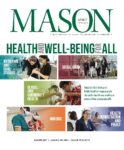Mason history professor Alison Landsberg doesn’t see films and television as an escape. She believes they can be rich historical sources, offering a window onto the social, political, cultural, and economic landscapes of their historical moment. In her latest book, Engaging the Past: Mass Culture and the Production of Historical Knowledge (Columbia University Press, 2015), she looks at how these “texts” provoke historical thinking.
How did you get into this field of study?
Much of my academic work has focused on how audiovisual texts such film and television “speak” to viewers. Unlike written texts, televisual and filmic texts engage the body of the spectator in a visceral, as well as intellectual, way. My first book, Prosthetic Memory: The Transformation of American Remembrance in the Age of Mass Culture (Columbia University Press, 2004), argued that with the birth of cinema at the turn of the 20th century images and narratives about the past began to circulate in an unprecedented way. As a result, people were able to feel an intimate, personal, affective connection to pasts that were not properly their own. I argue that these developments made it possible for people to take on memories of events through which they did not live in the traditional sense. Furthermore, because those memories were personally felt, they had the potential to shape the person’s identity and inform their worldview and politics. Taking on such memories enabled one to see through someone else’s eyes, potentially producing empathy and cross-cultural understanding.
What inspired you to write this book?
I noticed that there has been a proliferation of films, television shows in a range of genres, and even digital environments focused on the historical past. Because these audiovisual media tend to engage viewers viscerally, in an affective, bodily way, in addition to intellectually, I was curious about what this mode of address meant for the project of history more broadly.
Historians tend to be wary of this mode of address, preferring a clinical, distanced, purely intellectual look at the past. They tend to be critical of emotional or affective engagement. They worry that in these formats the complexity of the past will be reduced to a predictable struggle between good and evil. So I was curious about whether filmic and televisual texts—films like Hotel Rwanda and Milk, what I call historically conscious dramas like Mad Men, Deadwood, and Rome, and reality history television shows like Frontier House, Colonial House, and Texas Ranch House—might actually produce historical knowledge or foster historical thinking in viewers. Engaging the Past is an attempt to take these popular representations of the past seriously, and to understand their potential to foster in their viewers a powerful and yet complicated engagement with the past.
With people not reading as much as they did in previous generations, do you think these mediums now carry more weight with how we remember history.
Yes, I think these audiovisual texts have the potential to greatly influence what we think and how we think about the past. But for these texts to produce historical knowledge or foster historical thinking, they have to complicate the viewer’s sense that he or she can simply slip back into the past or fully know what happened. Even as they construct a past world, they must remind the viewer of the distance between the past and the present, they must force viewers out of the narrative.
In Mad Men, for example, although the show is seductive, drawing viewers into its world, it also revels in its ability to shock. Characters are openly sexist, racist, smoke in medical examining rooms, and so forth. These moments of difference are jarring, and as such they break the narrative illusion. Whether outraged or titillated by what he or she has just seen, the viewer is nevertheless forced into an awareness that he or she is thinking about the past. An awareness that one is thinking about the past and an interest in assessing the differences between then and now is an important first step toward historical thinking.


No Comments Yet »
Leave a comment